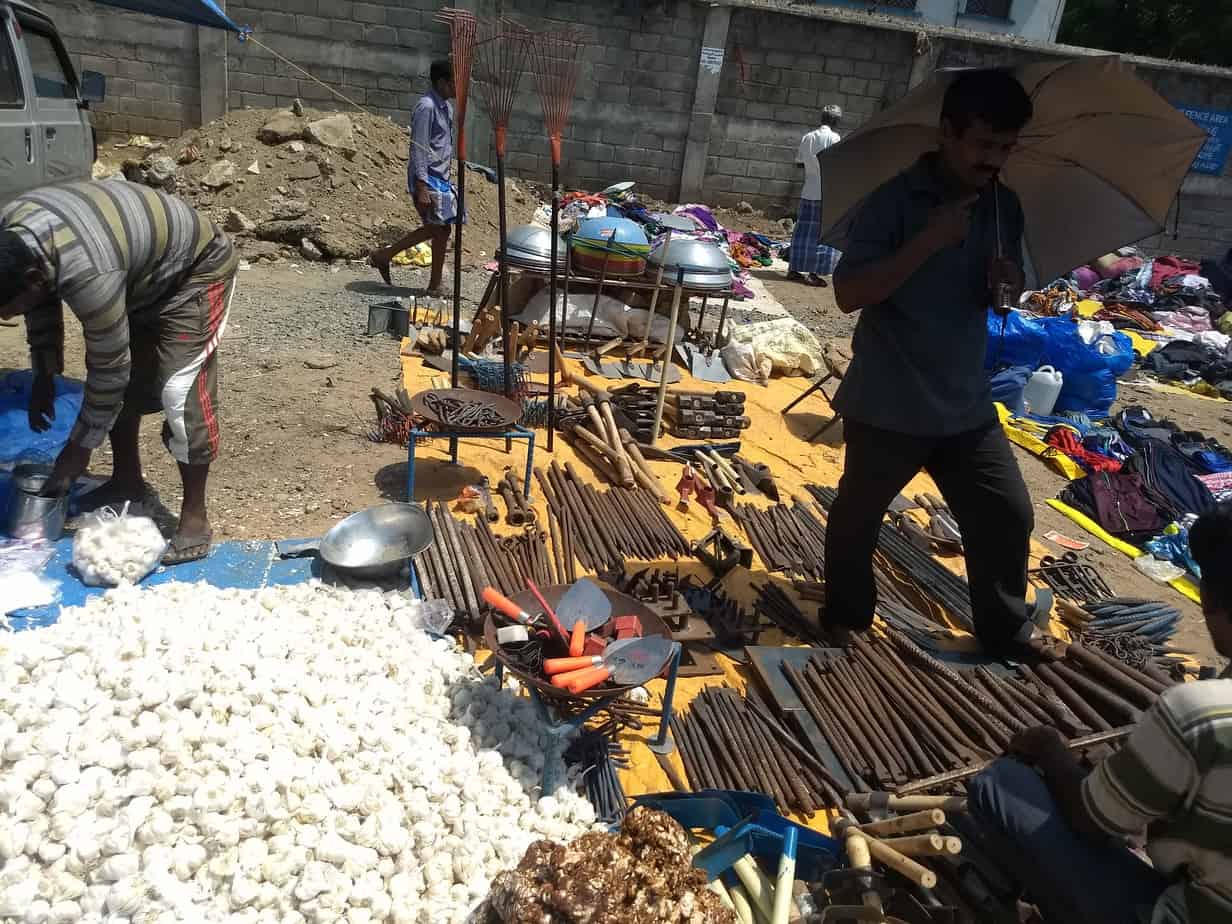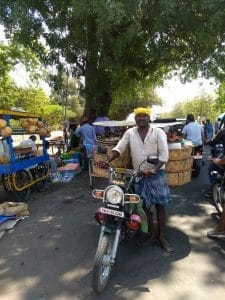“From a needle to a computer, you will get everything here,” said a lungi-clad old man, who was selling rare copper coins (half anna from 19th century) at the Friday Pallavaram market. With a brief pause, he chuckled, “Except a girl to get married to.”
Fresh vegetables, various varieties of fish, antique coins, old newspapers, eggs, chicken, batteries, computer spare parts… the list goes on. True to the trader’s words, the weekly Sandhai (market) that takes place every Friday on the Old Trunk Road of Pallavaram brings a village to the city. With just an umbrella or a wet cloth covering their heads to beat the heat, traders, who converge here from far-off villages to the south of Chennai, shout out tempting offers for the customers.

From veggies to tools, Pallavaram market has almost everything to run a household. Pic: Laasya Shekhar
Dating back to the Nawab era
The weekly market has a long history. Locals say that it was once a famous cattle market, frequented by farmers from the bordering villages of Andhra Pradesh and southern Tamil Nadu.
“Before it changed into an all-in-one market, it used to be an exclusive cattle market (maattu sandhai) located on Sandhai Road (named after the market), under the jurisdiction of St Thomas Mount-Pallavaram Cantonment, behind the hospital. Equipment for cattle including ropes, bells, paints for their horns were among many things sold. Oxen and old cows that gave no milk were sold for plowing and butchering respectively,” shares Badri Iyer, an 87-year-old civic activist.
But, why Friday — a question that heritage enthusiasts often ask. It is said that the weekly market came into existence during the rule of the Nawab of Arcot in Tamil Nadu. “The Nawabs, who were ruling from Arcot and had a few palaces in Madras in the 18th century, historically owed allegiance to the Mughal empire. Fridays were the days of feast during which goat and cow meat were cooked on a large scale. Economically, it worked well for the traders,” recalls S P Gandhi, President, Pallavaram Chapter, CITU Auto-Taxi drivers association. Traders used to arrive on Thursday night to organise the market and would wind up business by Friday evening.
Gandhi had collected information about Sandhai when he filed a case before the Madras High court seeking amenities for traders here. While he has sourced much of this information from locals, who in turn learnt it from their ancestors, historians are not so sure.
“History of local markets is badly documented in Tamil Nadu. Since places like Pallavaram and Saidapet did not fall within the erstwhile Madras Municipality, there is no documented information. Pallavaram market being among the unorganised ones, it is impossible to trace its origin,” says historian V Sriram.
A slow transformation
Soldiers and gazetted officers from the British empire found it fascinating to visit the weekly Pallavaram market. “It used to be their favourite past time,” says S Kanakaraju, a 75-year-old farmer at the Pallavaram market. Naturally however, the market has changed significantly since then.
“Once traders understood the patterns of demand and the popularity of the market, they started introducing fresh vegetables and other ingredients during the 1980s,” remembers Kanakaraju. Many citizens from Veteran Lines, an Anglo-Indian settlement near Pallavaram, still visit the market to stock on commodities for the week
The Cantonment, however, stopped the sale of cattle at the market around seven years ago, due to two reasons. “Contractors started demanding a lot of money from the farmers. Also, there was a fall in demand and supply, due to which the Cantonment discontinued the cattle market,” Gandhi explained.
Unlike the other markets (like Moore market) in the city that died a slow death, Pallavaram market continues to offer flourishing business to its traders. “We understand the needs of customers. As technology began to dominate our lives, we started selling electronic items, drones, spare parts of computers and vehicles,” says K Srinivasan, a trader.
Fight to survive
The attempts by the Cantonment to stop the bazaar, so that they could sell the land, was fought by the traders’ union who moved the Madras High court. The court directed the shift of the market from Sandhai Road to Old Trunk Road, ordering cantonment authorities to provide necessary amenities including a restroom and drinking water facility. It has been seven years since but the plea remains unfulfilled till date, rue traders.
“The bazaar is witness to a lot of irregularities. Each stall owner pays Rs 50 to the cantonment every week, as per the Government Order. Yet we are getting no facilities,” says Senthamarai C, who sells pickles here.
Beware of fraud!
The prices of commodities in the bazaar are less than in the super markets and malls, one of the reasons why it attracts a good crowd. A trader at the fish stall said that he sells a kilo of dry fish for Rs 80, which is half the price that super markets charge for the same.
As the sun goes down, traders throw tempting offers to clear their goods. “It is considered inauspicious to take back the goods. Besides, it is tough for these traders to stock them for resale, as a majority of them have no place for storage. They are farmers who sell their commodities without the interference of middlemen,” said Senthamarai.
Trusted insiders, however, also throw light on unethical practices in the Pallavaram market. “Some traders attach magnets under the weighing scales. For instance, if you buy a kilo of onions, you might have got only 800 gms,” said a trader, seeking anonymity.
If you are purchasing a new T-shirt at the market, be cautious. It could be an used garment collected from households, as donations. “They wash and iron these and sell them as new clothes,” the same trader mentioned.
Despite all odds, Pallavaram Market is the only weekly market in metropolitan Chennai that epitomises the rural Indian ‘bazaar’ culture. Come rain or sunshine, the market starts before dawn breaks every Friday. The determined traders say that they will fight the callousness of authorities to continue the market, not just in the interest of good economics, but as a way to preserve the age-old culture.

Nice interesting info about the sandhai.. Although visited couple of times, never got inquisitive about the history.. Good to know..
Setting apart the pre-lunch session this Friday for visiting this Santhai, with a mini-truck and a bag-load of small change. Thanks for the information, Lasya.